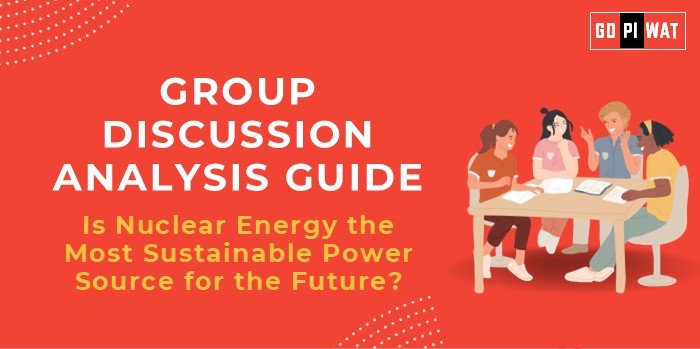🌍 Group Discussion Analysis Guide: Is Nuclear Energy the Most Sustainable Power Source for the Future?
🌟 Introduction to Nuclear Energy
Opening Context: “As nations strive to achieve net-zero emissions, nuclear energy emerges as a pivotal option in the global quest for sustainable power.”
Topic Background: Nuclear energy, harnessed through nuclear fission reactions, has been debated for decades. Advocates cite its low greenhouse gas emissions, while critics highlight safety and waste disposal concerns. Recent innovations in reactor technology are reviving interest globally.
📊 Quick Facts and Key Statistics
- Global Contribution: Nuclear energy provides about 10% of the world’s electricity, with over 440 reactors in operation.
- Carbon Emissions: Emits approximately 15g of CO₂ per kWh, compared to 450g for natural gas and 900g for coal.
- Safety Metrics: Despite high-profile accidents, nuclear has fewer fatalities per TWh than coal or oil.
- Energy Density: 1kg of uranium can produce as much energy as 1,500 tons of coal.
- Global Leaders: France derives 70% of its electricity from nuclear, showcasing a robust commitment to this energy source.
🔍 Stakeholders and Their Roles
- Governments: Set policies, fund research, and ensure safety regulations.
- Energy Corporations: Operate reactors and invest in technological innovations like Small Modular Reactors (SMRs).
- Environmental Groups: Advocate for or against nuclear energy based on sustainability and ecological concerns.
- Communities: Influence acceptance and success through public opinion, especially in areas near nuclear plants.
- International Bodies: Organizations like the IAEA promote safe and efficient use of nuclear technology.
🏆 Achievements and Challenges
- Achievements:
- Decarbonization: A key contributor to low-emission electricity in Europe and North America.
- Energy Reliability: Unlike solar and wind, nuclear provides constant baseload power.
- Technological Advances: Progress in SMRs and waste recycling offers potential for safer, more efficient energy generation.
- Challenges:
- Nuclear Waste: Long-term storage and disposal remain unresolved globally.
- High Costs: Initial setup and decommissioning expenses deter investment.
- Public Safety Concerns: Incidents like Chernobyl and Fukushima impact public trust.
🌍 Global Comparisons
France: A leader in nuclear technology and waste reprocessing.
Germany: Phasing out nuclear despite sustainability goals, emphasizing renewables.
📚 Structured Arguments for Discussion
- Supporting Stance: “Nuclear energy’s unmatched energy density and low emissions make it the most viable option for achieving global sustainability goals.”
- Opposing Stance: “The unsolved issues of nuclear waste disposal and high costs question its long-term sustainability.”
- Balanced Perspective: “While nuclear energy offers a low-carbon solution, complementing it with renewables can create a safer and more diverse energy mix.”
📝 Effective Discussion Approaches
- Opening Approaches:
- “Nuclear energy produces less CO₂ than almost any other source, positioning it as essential in combating climate change.”
- “With 70% of its energy from nuclear, France exemplifies how nuclear can lead to energy independence and sustainability.”
- Counter-Argument Handling:
- Address waste concerns by highlighting recycling technologies.
- Mitigate cost arguments with examples of falling SMR costs.
⚖️ Strategic Analysis of Strengths and Weaknesses
- Strengths: Low emissions, reliable baseload power, high energy density.
- Weaknesses: Waste management, high costs, accident risks.
- Opportunities: Technological advancements, global net-zero initiatives.
- Threats: Public opposition, competition from renewables.
📊 Connecting with B-School Applications
- Real-World Applications: Case studies on energy mix optimization or sustainability-driven business strategies.
- Sample Interview Questions:
- “How does nuclear energy compare to renewables in long-term sustainability?”
- “Discuss the role of SMRs in reshaping global energy policy.”
- Insights for Students: Explore nuclear energy in projects related to energy economics or environmental policy.


